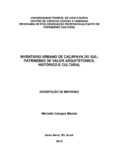| dc.creator | Morais, Michelle Campos | |
| dc.date.accessioned | 2014-07-10 | |
| dc.date.available | 2014-07-10 | |
| dc.date.issued | 2013-03-13 | |
| dc.identifier.citation | MORAIS, Michelle Campos. Urban inventory of Caçapava do Sul: patrimony of architectural, historical and cultural value. 2013. 140 f. Dissertação (Mestrado em História) - Universidade Federal de Santa Maria, Santa Maria, 2013. | por |
| dc.identifier.uri | http://repositorio.ufsm.br/handle/1/11016 | |
| dc.description.abstract | Due to the fact of knowing its past, the community must understand the necessity of knowing its patrimony, because it preserves its history. The architecture is one of the main manifestations for the analyses and understanding of the cities history, considering that the buildings are an important means of recognizing and urban reference. One should emphasize that it is essential, before any preservationist action, to identify and collect all the data regarding the patrimonial assets to be protected. The inventory control is also used as a preservation tool, which besides its documentation, is able to maintain the collective memory, providing respect and value of the assets. From that moment on, the result of this study refers to the patrimonial inventory of architectural, historical and cultural value, considering the updated registration of built examples in the urban area in the city of Caçapava do Sul. In 1987, an inventory of the city s assets was carried out, it was entitled as Caçapava Project , sixty-eight urban and thirty-nine rural properties were considered in it. In order to research about the present situation of such properties, the criterion of territorial delimitation was established with the purpose to select the properties to take inventory in the research. The Zone of patrimony s interest will be considered, according to the Municipal Development Master Plan, considering twenty-four properties listed in the inventory of 1987, taking into account that two assets were destroyed and twenty-two are remainders and will take inventory in the research. In conclusion, the intention is to collaborate concerning knowledge and dissemination for the community, rescuing the urban memory, encouraging the preservation and providing subsidies which may contribute substantially for the public policies and for the action plan in the areas of patrimony preservation in the city. | eng |
| dc.format | application/pdf | por |
| dc.language | por | por |
| dc.publisher | Universidade Federal de Santa Maria | por |
| dc.rights | Acesso Aberto | por |
| dc.subject | Arquitetura | por |
| dc.subject | Edificação | por |
| dc.subject | Inventário | por |
| dc.subject | Patrimônio | por |
| dc.subject | Architecture | eng |
| dc.subject | Building | eng |
| dc.subject | Inventory | eng |
| dc.subject | Patrimony | eng |
| dc.title | Inventário urbano de Caçapava do Sul: patrimônio de valor arquitetônico, histórico e cultural | por |
| dc.title.alternative | Urban inventory of Caçapava do Sul: patrimony of architectural, historical and cultural value | eng |
| dc.type | Dissertação | por |
| dc.description.resumo | A comunidade, para conhecer o seu passado, deve ter o entendimento da necessidade de conhecer o seu patrimônio, pois ele conserva a sua história. A arquitetura é uma das principais manifestações para a análise e entendimento da história das cidades, sendo as edificações importante meio de reconhecimento e de referência urbana. Ressalta-se que é fundamental antes de qualquer ação preservacionista identificar e coletar todas as informações pertinentes dos bens patrimoniais a serem protegidos. Faz-se uso do inventário como instrumento de preservação, que além da documentação, é capaz de conservar a memória coletiva, proporcionando o respeito e a valorização dos bens. A partir daí, o resultado do presente trabalho refere-se ao inventário do patrimônio de valor arquitetônico, histórico e cultural, sendo o registro atualizado de exemplares edificados na área urbana de cidade de Caçapava do Sul. No ano de 1987, foi realizado o inventário dos bens municipais, intitulado Projeto Caçapava , tendo sido contemplados setenta e oito imóveis urbanos e trinta e nove imóveis rurais. A fim de pesquisar a situação atual de tais bens, estabeleceu-se o critério de delimitação territorial para a seleção dos bens a serem inventariados na pesquisa. Será contemplada a Zona de interesse do patrimônio segundo o Plano Diretor de Desenvolvimento Municipal, contemplando vinte e quatro bens listados no inventário de 1987, sendo que destes, dois bens foram destruídos e vinte e dois bens são remanescentes e serão inventariados na pesquisa. Como conclusão, pretende-se colaborar no sentido de conhecimento e divulgação para a comunidade, resgatando a memória urbana, incentivando a preservação e fornecendo subsídios que podem contribuir substancialmente para as políticas públicas e para os planos de ações nas áreas de preservação patrimonial no município. | por |
| dc.contributor.advisor1 | Saad, Denise de Souza | |
| dc.contributor.advisor1Lattes | http://lattes.cnpq.br/5104361169659851 | por |
| dc.contributor.referee1 | Lopes, Caryl Eduardo Jovanovich | |
| dc.contributor.referee1Lattes | http://lattes.cnpq.br/0701827238095286 | por |
| dc.contributor.referee2 | Grigoletti, Giane de Campos | |
| dc.contributor.referee2Lattes | http://lattes.cnpq.br/9725292275606192 | por |
| dc.creator.Lattes | http://lattes.cnpq.br/8700759501608954 | por |
| dc.publisher.country | BR | por |
| dc.publisher.department | História | por |
| dc.publisher.initials | UFSM | por |
| dc.publisher.program | Programa de Pós-Graduação em Patrimônio Cultural | por |
| dc.subject.cnpq | CNPQ::CIENCIAS HUMANAS::HISTORIA | por |


